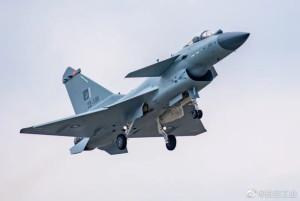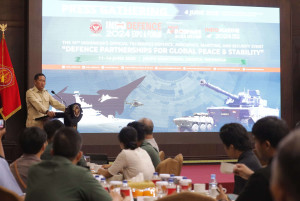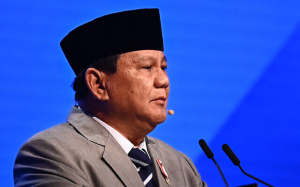Defense ministry evaluates Chinese J-10 Fighter Jet offer
The Ministry of Defense is studying the potential procurement of China’s J-10 fighter jets, though no official decision has been made, said Deputy Defense Minister Donny Ermawan Taufanto.
Speaking to reporters on Wednesday, June 4, 2025, Donny responded to growing speculation about Indonesia’s interest in acquiring the multirole combat aircraft from China, following a recent visit by Indonesian Air Force Chief of Staff, Air Chief Marshal M. Tonny Harjono to the country.
“The rumor started when our Air Force Chief visited China and attended an Air Show there. He saw the J-10 on display and was offered the aircraft,” Donny said at the ministry's headquarters in Jakarta.
He clarified that the J-10 offer remains in a preliminary stage and is under initial consideration. “It’s still a rumor, really. We haven't sent a team nor entered a detailed evaluation phase yet.”
Neutral stance
Donny emphasized Indonesia’s non-aligned foreign policy, asserting the country’s right to source military equipment from any countries, including China, as long as it aligns with national defense needs.
“We are a neutral country. We’re not bound to any military alliances. That gives us the flexibility to procure weapons from any nations, China included,” he said.
“If the aircraft meets our criteria and is offered at a competitive price, then why not?” he added.
While a final decision is pending, Donny outlined several performance benchmarks that any prospective fighter jet must meet, including range, combat capability, and weapons payload.
“We need to assess its operational range, what kind of armaments it can carry, and its overall performance. All of that will factor into our evaluation,” he cited.
Despite growing speculation, Donny confirmed that the government has not yet dispatched an official delegation to China to conduct a technical review or feasibility study on the J-10.
In a rare media interview held inside a military aircraft hangar in Chengdu, veteran Chinese aircraft designer Xie Pin, who is also former deputy chief designer of the J-10 fighter jet, revealed key technological advancements and the enduring capabilities of one of China's most prominent combat aircraft.
Nicknamed the Vigorous Dragon, the J-10 has been a centerpiece of China’s airpower strategy. Despite its development beginning over four decades ago, its latest export variant, the J-10CE, continues to impress military observers for its agility, firepower, and adaptability on the modern battlefield.
“It’s been more than 40 years since the J-10 project began, yet it still looks modern and beautiful,” Xie, 86, told local media.
The J-10 is a single-engine, multirole fighter jet developed by AVIC Chengdu Aircraft Industrial. The aircraft's delta wing and canard configuration provide it with high maneuverability and superior lift, crucial in close-range dogfights and high-G turns. According to Xie, these aerodynamic enhancements are not just theoretical.
“When the canard generates vortices that pass over the main wings, it speeds up airflow and enhances lift. This makes the aircraft extremely agile,” he explained.
Next-gen enhancements
The J-10CE, the upgraded export version of the platform, integrates collaborative combat capabilities, multi-target long-range strike, and precision-guided attack modes. These systems are designed to function effectively even under intense electromagnetic interference, a growing feature of modern warfare.
Xie highlighted the aircraft's radar detection range of up to 200 kilometers, a significant leap from earlier Chinese fighters like the J-7 and J-8, which he referred to as “nearsighted” in comparison.
“Back then, our fighters couldn’t detect targets at long range. Now, the J-10 has eyes that can see far,” he said.
The aircraft features 11 external hardpoints, enabling it to carry long-range missiles, electronic warfare pods, and other mission-specific payloads. This makes it a formidable opponent in both air-to-air and air-to-ground engagements.
In a notable evolution, the J-10CE incorporates stealth features uncommon for aircraft of its generation. The cockpit is coated with radar-absorbent material, and its clamshell’ air intake, positioned beneath the fuselage, minimizes radar cross-section while enhancing airflow efficiency.
“This intake design allows low-energy boundary air to be directed through a center slit and expelled, reducing drag while keeping the structure light,” Xie said.
Such upgrades are part of China’s broader push to modernize its aerial combat fleet, making older platforms like the J-10CE remain relevant in an age increasingly defined by stealth and network-centric warfare.
Strategic implications
The J-10CE has recently gained renewed attention amid discussions about potential acquisitions by other countries, including Indonesia. Chinese military aircraft, once dismissed as inferior copies, are now being seriously evaluated for their cost-effectiveness and improved performance.
While the Chinese government has not confirmed any recent deals, the aircraft's enhanced capabilities and Xie’s public endorsement signal Beijing’s confidence in the platform’s export potential.
Already have an account? Sign In
-
Start reading
Freemium
-
Monthly Subscription
20% OFF$29.75
$37.19/MonthCancel anytime
This offer is open to all new subscribers!
Subscribe now -
Yearly Subscription
33% OFF$228.13
$340.5/YearCancel anytime
This offer is open to all new subscribers!
Subscribe now







